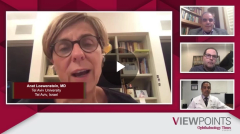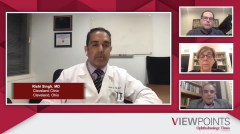
Treatment options for DR/DME
The role of DRCR.net clinical trials in guiding the management of DR/DME and a review of the safety and efficacy of anti-VEGF agents.
Episodes in this series

Rishi Singh, MD: Dr Loewenstein, we’ve had a plethora of data in the past years about how to treat these patients with DME [diabetic macular edema]. Can you talk a bit about the data that now help guide your treatment algorithm for patients with DME?
Anat Loewenstein, MD: I can talk about this for hours, but I’ll try to summarize it. First of all, we have the data from the Protocol V trial that says exactly what Steven said: If a patient has good visual acuity, according to Protocol V, you don’t need to treat them up front if you follow up on them. If it’s a patient who will not come to follow-up visits, then I would even treat a patient with good visual acuity. Once the visual acuity is not perfect, if the edema is not in the center, then I might also follow up with the patient.
If I have central macular edema, I will usually treat the patient. If the patient has good visual acuity, then according to Protocol V, all 3 treatments that we have available for us nowadays, which are bevacizumab, ranibizumab, and aflibercept, are all good treatments. They are the same, but if the patient has less than optimal visual acuity, 20/50 or worse, then there is an advantage to one drug over the other. I’m not saying that the difference is huge. The difference is mainly toward bevacizumab, but I try to switch as fast as I can to one of the registered drugs. This is one aspect of the clinical trials.
Another aspect of the clinical trials is the issue that we can treat peripheral disease with anti-VEGF therapy, and we have that from the Protocol S trial from the DRCR.net [Diabetic Retinopathy Clinical Research Network] as well as from the CLARITY trial. That is another trial outside of the DRCR.net. For me, these are the most important trials that show how to treat patients with diabetic macular edema and diabetic retinopathy. There are many other trials, as well as trials that show that it’s not usually helpful enough to use anti-VEGF treatment in patients with NPDR [nonproliferative diabetic retinopathy] to lower the chances of developing [proliferative diabetic retinopathy]. That is probably not needed at this point, according to the knowledge we have from the newer trials.
Rishi Singh, MD: When you look at the treatment options, what about the safety data that you see? Are all these drugs considered safe at this point for diabetic macular edema? Is there any concern about the systemic or local adverse effect profiles of these drugs?
Anat Loewenstein, MD: From the drugs that we have in our armamentarium nowadays, the 3 main drugs don’t have significant local safety issues. We have new drugs that came out that showed an inflammatory response, some of which includes occlusive vasculitis with closure of blood vessels. Blood vessel closure, even with larger blood vessels, raises an ocular safety concern. With the 3 main drugs that we are using recently, there is still a question about whether there is a systemic adverse effect issue. There have been multiple meta-analyses, one of which said that yes, there is an issue there. The researchers said that the studies are not powered to show an issue, so I’m not sure if there is an issue, but I do have it in the back of my mind.
If I have a patient who just had a stroke or an MI [myocardial infarction], I will probably refrain from giving an anti-VEGF agent in the first month or two even though it’s not 100% proven that I’m right by doing so. In many of these cases, I will use a steroid as the primary therapy, with all the caveats that they have. We can also use intravitreal steroids by way of long-lasting implant of dexamethasone, and I use it as primary treatment mostly for patients who cannot come for monthly treatment, but they can measure the pressure, or I use it for patients who just had a stroke or an MI.
A panel of experts in ophthalmology and optometry review the diagnosis and treatment of diabetic eye disease including emerging agents in the field.
Newsletter
Get the essential updates shaping the future of pharma manufacturing and compliance—subscribe today to Pharmaceutical Technology and never miss a breakthrough.













































